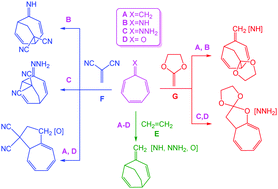Understanding the higher–order cycloaddition reactions of heptafulvene, tropone, and its nitrogen derivatives, with electrophilic and nucleophilic ethylenes inside the molecular electron density theory†
Abstract
The higher–order cycloaddition reactions of four cycloheptatriene (CHT) derivatives, heptafulvene, tropone, and the imine and ylidenehydrazine derivatives with ethylene, electrophilic dicyanoethylene (DCE), and nucleophilic cyclic ketene acetal (CKA) have been studied within the molecular electron density theory (MEDT) at the ωB97X-D/6-311G(d,p) level. The electron localization function (ELF) indicates that the substitution at the X8 position of these CHTs only affects the electron density of the C1–X8 bonding region, and the CHT core being only slightly polarized. The reactivity indices classify heptafulvene and the two nitrogen derivatives as strong nucleophiles and tropone and the ylidenehydrazine as strong electrophiles participating in polar reactions. Parr functions show that the C2 and C4 positions are the more electrophilic, while the X8, C2, and C4 positions are the more nucleophilic of these CHTs. The activation energies of these CHTs decrease in the order: ethylene > CKA > DCE in agreement with the reactivity indices. The polar cycloaddition reactions with DCE are completely regioselective, while the reactions of heptafulvene and the imine with CKA are highly regio- and pseudocyclic selective, yielding the [4+2] cycloadducts, and those of tropone and ylidenehydrazine are highly regio- and pseudocyclic selective yielding the [8+2] cycloadducts. This MEDT study makes it possible to explain how the substitution at the X8 center of these CHTs changes the reactivity and selectivity of these higher-order cycloaddition reactions.



 Please wait while we load your content...
Please wait while we load your content...